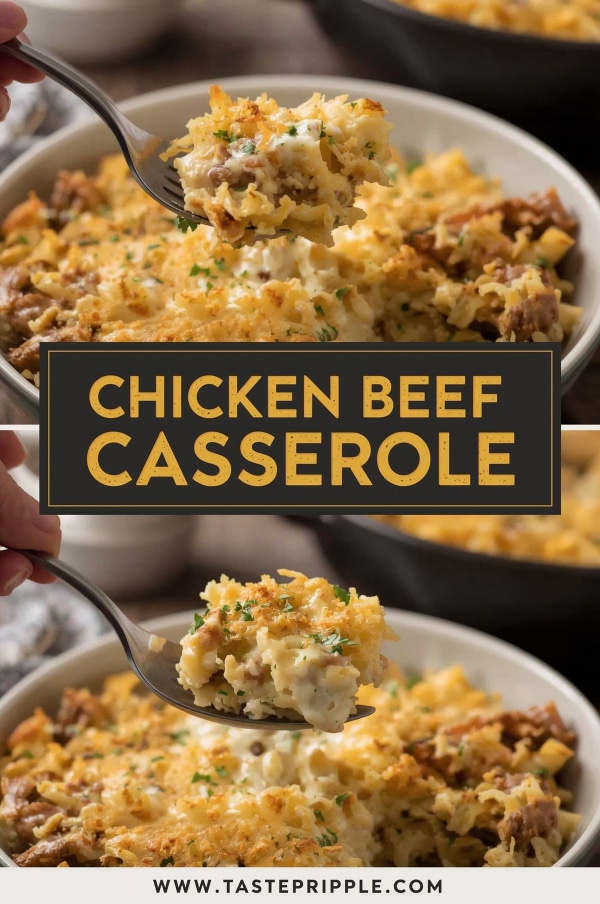I remember once walking into a small-town diner somewhere in the middle of Oklahoma. The waitress placed down a steaming, golden-brown dish that smelled like heaven in a skillet. It had layers of tender beef, juicy chicken, melted cheese, and that unmistakable tang of ranch. No pretension, no fuss—just pure comfort. That was my first encounter with something close to what we now call a Chicken Beef Ranch Casserole. Funny thing is, I wasn’t even that hungry, but I cleaned the plate without even noticing.
This dish is a bit of a hybrid. You’ve got beef, which brings depth and that grounding, savory punch. Then comes chicken, leaner but carrying a lighter flavor that softens the heaviness of beef. Tie it all together with creamy ranch dressing, layers of pasta or potatoes, cheese bubbling on top, and you’ve got yourself a casserole that doesn’t just feed—it hugs you. Some call it over-the-top. I call it balance in chaos.
Unlike many casseroles that stick to just one protein, this one leans into the luxury of two. It feels slightly rebellious, like breaking the unspoken rule of “pick one meat and stick with it.” But that’s what makes it so special. The interplay of textures and flavors is like an orchestra tuning itself into harmony. Ranch acts as the conductor here, pulling all the parts together into one creamy, tangy melody.
Ingredients & Substitutions
Every casserole rises or falls on the shoulders of its ingredients. Skimp on the cheese and you’ll get something flat. Go cheap on the ranch and you’ll notice. I always tell my apprentices: casseroles are deceptively simple. The ingredient list looks easy, but the smallest compromise can taste like disaster.
Here’s a breakdown of what you’ll need. I’ll also toss in substitutions because no two kitchens are the same, and sometimes your fridge is missing exactly what you want.
Ingredient Table
| Ingredient | Measurement | Notes & Substitutions |
|---|---|---|
| Ground beef (80/20) | 1 pound (450 g) | Can sub with ground turkey or pork, but beef gives depth |
| Chicken breast, diced | 2 cups (about 2 breasts) | Thighs work well for juicier texture |
| Onion, chopped | 1 medium | Shallots for sweeter flavor |
| Garlic, minced | 3 cloves | Powder works, but fresh gives punch |
| Ranch dressing | 1 cup (240 ml) | Use homemade for better tang |
| Cream cheese | 4 oz (113 g) | Greek yogurt works for lighter version |
| Shredded cheddar cheese | 2 cups (200 g) | Monterey Jack for milder melt |
| Cooked pasta (penne) | 4 cups (about 12 oz) | Potatoes or rice as hearty swaps |
| Bell pepper, chopped | 1 large | Skip or add jalapeño for spice |
| Corn (optional) | 1 cup (150 g) | Adds sweetness, frozen is fine |
| Salt & black pepper | To taste | Season generously, ranch alone isn’t enough |
| Olive oil | 2 tbsp | Butter gives richer flavor |
| Fresh parsley | 2 tbsp, chopped | Cilantro adds brightness instead |
The choice of beef matters. Go with an 80/20 grind—enough fat to keep it juicy, not so much it floods the casserole with grease. Chicken breast gives a leaner bite, but if you like more succulence, chicken thighs win every time. And the ranch? Homemade makes a difference—store-bought tends to be sweeter, while a scratch-made ranch leans herby and bold.
Step-by-Step Instructions
This casserole isn’t rocket science, but that doesn’t mean you can rush through it. Timing matters. Texture matters. The way you brown your beef will echo through the entire dish.
Step 1: Sear the beef
Heat a skillet over medium-high. Add a splash of olive oil and drop in the beef. Don’t stir too much at first—let it brown, develop that crust. That crust is flavor. Break it apart after it’s seared. Drain excess fat but keep just a touch for richness. Common mistake? Overcooking until it’s dry and crumbly.
Step 2: Cook the chicken
In the same skillet, toss in your diced chicken. Season lightly. You’re not looking for full golden-brown here, just cooked through. Overcooked chicken in a casserole tastes like cardboard. Stop just when it turns opaque—it’ll finish cooking in the oven.
Step 3: Aromatics
Add onion, garlic, bell pepper. Sauté until softened. You want that onion sweetness, not the raw bite. Garlic burns faster than you think, so keep the heat medium.
Step 4: Build the sauce
Drop in cream cheese, let it melt gently. Stir in ranch dressing. Suddenly the kitchen smells like game day. Toss in half the cheddar cheese. If it looks too thick, add a splash of milk. The sauce should cling, not drown.
Step 5: Assemble
Mix the sauce with cooked pasta. Fold in beef, chicken, corn if using. Everything should be coated, no lonely noodles. Pour into a greased casserole dish. Top with the rest of the cheese.
Step 6: Bake
350°F (175°C), about 25 minutes. You’re aiming for bubbly edges and golden cheese on top. Let it rest five minutes before serving—cheese needs to set slightly, otherwise it runs everywhere.
Variations
For spicy lovers, throw in cayenne or jalapeños. Want a lighter feel? Use zucchini noodles instead of pasta. Craving crunch? Sprinkle crushed tortilla chips or breadcrumbs on top before baking.
Cooking Techniques & Science
Why sear beef first? The Maillard reaction. It’s chemistry—amino acids and sugars meet heat, creating hundreds of flavor compounds. If you skip searing, your beef just tastes boiled.
Chicken is trickier. It doesn’t have the fat cushion that beef does, so it dries faster. Cooking it only partway before the oven saves it.
Ranch is the glue. Fat from mayo or sour cream binds, herbs bring freshness, acid balances the richness. Without ranch, this dish collapses into just meat and pasta.
Storage & Reheating
Cool leftovers quickly. Refrigerate in airtight containers up to 4 days. Freezing works too, though the texture of pasta softens. Reheat covered at 325°F (160°C), splash of milk stirred in to revive creaminess. Microwaves do the job, but casseroles come back to life in ovens.
Tools
Use a cast-iron skillet for searing. Holds heat, creates that beef crust. Glass baking dish for casserole—lets you see the bubbling sides and doesn’t impart metallic taste like some pans.
Serving & Pairing Suggestions
Don’t just scoop and dump it on plates. Cut into squares if it’s set well, garnish with fresh parsley. That green fleck against creamy cheese is more than decoration—it resets the palate.
Pair it with a crisp salad. Something acidic, like arugula with lemon vinaigrette. It balances the heaviness. Bread works too—garlic bread especially. For drinks, a light beer cuts richness, while iced tea offers a softer pairing.
Best Time to Serve
This isn’t summer picnic food. It’s fall evenings, football Sundays, midweek family dinners when everyone’s exhausted. Serve it when you want silence at the table except for forks scraping plates. Leftovers reheat beautifully, so it doubles as a make-ahead for busy weeks.
Conclusion
Chicken Beef Ranch Casserole isn’t refined. It doesn’t belong in a Michelin-star dining room. But that’s the beauty of it. It’s hearty, messy, layered comfort.
The secret lies in balance. Don’t dry out the chicken, don’t drown the noodles, don’t skimp on ranch. Get those things right, and you’ve got a dish that satisfies the soul. For professionals, it’s a reminder that food doesn’t always need to be fancy. Sometimes it just needs to be good.
FAQs
Can I make this ahead of time?
Yes. Assemble the casserole, cover, refrigerate up to 24 hours, then bake. Add 5–10 minutes extra to the bake time if starting cold.
What’s the best cheese to use?
Cheddar is classic, but blends like cheddar-Jack melt creamier. Avoid pre-shredded if possible—those anti-caking powders mess with melt.
Can I make it gluten-free?
Sure. Swap pasta for gluten-free noodles or rice. Double-check your ranch dressing since some brands add hidden gluten.
How do I make it healthier?
Use chicken thighs only, swap pasta for zucchini noodles, Greek yogurt for cream cheese, and reduced-fat cheddar. It won’t taste identical but still satisfies.
Why use both chicken and beef?
Each brings something. Beef adds deep, savory notes while chicken lightens the dish. Ranch ties them together. Without both, you lose contrast.

